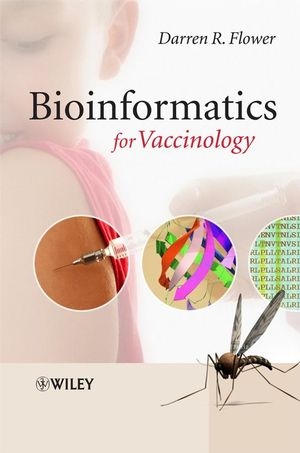
Bioinformatics for Vaccinology
John Wiley & Sons Inc (Verlag)
978-0-470-02711-0 (ISBN)
“… this book was written from start to finish by one extremely dedicated and erudite individual. The author has done an excellent job of covering the many topics that fall under the umbrella of computational biology for vaccine design, demonstrating an admirable command of subject matter in fields as disparate as object-oriented databases and regulation of T cell response. Simply put, it has just the right breadth and depth, and it reads well. In fact, readability is one of its virtues—making the book enticing and useful, all at once…” Human Vaccines, 2010 "... This book has several strong points. Although there are many textbooks that deal with vaccinology, few attempts have been made to bring together descriptions of vaccines in history, basic bioinformatics, various computational solutions and challenges in vaccinology, detailed experimental methodologies, and cutting-edge technologies... This book may well serve as a first line of reference for all biologists and computer scientists..." –Virology Journal, 2009
Vaccines have probably saved more lives and reduced suffering in a greater number of people than any other medical intervention in human history, succeeding in eradicating smallpox and significantly reducing the mortality and incidence of other diseases. However, with the emergence of diseases such as SARS and the threat of biological warfare, vaccination has once again become a topic of major interest in public health.
Vaccinology now has at its disposal an array of post-genomic approaches of great power. None has a more persuasive potential impact than the application of computational informatics to vaccine discovery; the recent expansion in genome data and the parallel increase in cheap computing power have placed the bioinformatics exploration of pathogen genomes centre stage for vaccine researchers.
This is the first book to address the area of bioinformatics as applied to rational vaccine design, discussing the ways in which bioinformatics can contribute to improved vaccine development by
introducing the subject of harnessing the mathematical and computing power inherent in bioinformatics to the study of vaccinology
putting it into a historical and societal context, and
exploring the scope of its methods and applications.
Bioinformatics for Vaccinology is a one-stop introduction to computational vaccinology. It will be of particular interest to bioinformaticians with an interest in immunology, as well as to immunologists, and other biologists who need to understand how advances in theoretical and computational immunobiology can transform their working practices.
Dr Darren R Flower, Reader in Pharmacy, School of Life and Health Sciences, University of Aston, Birmingham, UK.
Preface xiii
Acknowledgements xv
Exordium xvii
1 Vaccines: Their place in history 1
Smallpox in history 1
Variolation 3
Variolation in history 5
Variolation comes to Britain 6
Lady Mary Wortley Montagu 9
Variolation and the Sublime Porte 11
The royal experiment 13
The boston connection 14
Variolation takes hold 17
The Suttonian method 18
Variolation in Europe 19
The coming of vaccination 21
Edward Jenner 23
Cowpox 26
Vaccination vindicated 28
Louis Pasteur 29
Vaccination becomes a science 30
Meister, Pasteur and rabies 31
A vaccine for every disease 33
In the time of cholera 34
Haffkine and cholera 36
Bubonic plague 37
The changing face of disease 39
Almroth wright and typhoid 40
Tuberculosis, Koch, and Calmette 43
Vaccine BCG 44
Poliomyelitis 46
Salk and Sabin 47
Diphtheria 49
Whooping cough 50
Many diseases, many vaccines 51
Smallpox: Endgame 53
Further reading 54
2 Vaccines: Need and opportunity 55
Eradication and reservoirs 55
The ongoing burden of disease 57
Lifespans 57
The evolving nature of disease 59
Economics, climate and disease 60
Three threats 60
Tuberculosis in the 21st century 61
HIV and AIDS 62
Malaria: Then and now 63
Influenza 64
Bioterrorism 65
Vaccines as medicines 67
Vaccines and the pharmaceutical industry 68
Making vaccines 70
The coming of the vaccine industry 70
3 Vaccines: How they work 73
Challenging the immune system 73
The threat from bacteria: Robust, diverse, and endemic 74
Microbes, diversity and metagenomics 75
The intrinsic complexity of the bacterial threat 76
Microbes and humankind 77
The nature of vaccines 78
Types of vaccine 80
Carbohydrate vaccines 82
Epitopic vaccines 82
Vaccine delivery 83
Emerging immunovaccinology 84
The immune system 85
Innate immunity 86
Adaptive immunity 88
The microbiome and mucosal immunity 90
Cellular components of immunity 90
Cellular immunity 93
The T cell repertoire 93
Epitopes: The immunological quantum 94
The major histocompatibility complex 95
MHC nomenclature 97
Peptide binding by the MHC 98
The structure of the MHC 99
Antigen presentation 101
The proteasome 101
Transporter associated with antigen processing 103
Class II processing 103
Seek simplicity and then distrust it 104
Cross presentation 105
T cell receptor 106
T cell activation 108
Immunological synapse 109
Signal 1, signal 2, immunodominance 109
Humoral immunity 110
Further reading 112
4 Vaccines: Data and databases 113
Making sense of data 113
Knowledge in a box 114
The science of -omes and -omics 115
The proteome 115
Systems biology 116
The immunome 117
Databases and databanks 118
The relational database 119
The XML database 119
The protein universe 120
Much data, many databases 122
What proteins do 122
What proteins are 124
The amino acid world 124
The chiral nature of amino acids 127
Naming the amino acids 130
The amino acid alphabet 132
Defining amino acid properties 134
Size, charge and hydrogen bonding 135
Hydrophobicity, lipophilicity and partitioning 136
Understanding partitioning 139
Charges, ionization, and pka 140
Many kinds of property 143
Mapping the world of sequences 146
Biological sequence databases 147
Nucleic acid sequence databases 148
Protein sequence databases 149
Annotating databases 150
Text mining 151
Ontologies 153
Secondary sequence databases 154
Other databases 155
Databases in immunology 156
Host databases 156
Pathogen databases 159
Functional immunological databases 161
Composite, integrated databases 162
Allergen databases 163
Further reading 165
Reference 165
5 Vaccines: Data driven prediction of binders, epitopes and immunogenicity 167
Towards epitope-based vaccines 167
T cell epitope prediction 168
Predicting MHC binding 169
Binding is biology 172
Quantifying binding 173
Entropy, enthalpy and entropy-enthalpy compensation 174
Experimental measurement of binding 175
Modern measurement methods 177
Isothermal titration calorimetry 178
Long and short of peptide binding 179
The class I peptide repertoire 180
Practicalities of binding prediction 181
Binding becomes recognition 182
Immunoinformatics lends a hand 183
Motif based prediction 184
The imperfect motif 185
Other approaches to binding prediction 186
Representing sequences 187
Computer science lends a hand 188
Artificial neural networks 188
Hidden Markov models 190
Support vector machines 190
Robust multivariate statistics 191
Partial least squares 191
Quantitative structure activity relationships 192
Other techniques and sequence representations 193
Amino acid properties 194
Direct epitope prediction 195
Predicting antigen presentation 196
Predicting class II MHC binding 197
Assessing prediction accuracy 199
ROC plots 202
Quantitative accuracy 203
Prediction assessment protocols 204
Comparing predictions 206
Prediction versus experiment 207
Predicting B cell epitopes 208
Peak profiles and smoothing 209
Early methods 210
Imperfect B cell prediction 211
References 212
6 Vaccines: Structural approaches 217
Structure and function 217
Types of protein structure 219
Protein folding 220
Ramachandran plots 221
Local structures 222
Protein families, protein folds 223
Comparing structures 223
Experimental structure determination 224
Structural genomics 226
Protein structure databases 227
Other databases 228
Immunological structural databases 229
Small molecule databases 230
Protein homology modelling 231
Using homology modelling 232
Predicting MHC supertypes 233
Application to alloreactivity 235
3D-QSAR 236
Protein docking 238
Predicting B cell epitopes with docking 238
Virtual screening 240
Limitations to virtual screening 241
Predicting epitopes with virtual screening 243
Virtual screening and adjuvant discovery 244
Adjuvants and innate immunity 245
Small molecule adjuvants 246
Molecular dynamics and immunology 248
Molecular dynamics methodology 249
Molecular dynamics and binding 249
Immunological applications 250
Limitations of molecular dynamics 251
Molecular dynamics and high performance computing 252
References 253
7 Vaccines: Computational solutions 257
Vaccines and the world 257
Bioinformatics and the challenge for vaccinology 259
Predicting immunogenicity 260
Computational vaccinology 261
The threat remains 262
Beyond empirical vaccinology 262
Designing new vaccines 263
The perfect vaccine 264
Conventional approaches 265
Genome sequences 266
Size of a genome 267
Reverse vaccinology 268
Finding antigens 269
The success of reverse vaccinology 271
Tumour vaccines 273
Prediction and personalised medicine 275
Imperfect data 276
Forecasting and the future of computational vaccinology 277
Index 283
| Erscheint lt. Verlag | 31.12.2008 |
|---|---|
| Verlagsort | New York |
| Sprache | englisch |
| Maße | 172 x 248 mm |
| Gewicht | 538 g |
| Themenwelt | Informatik ► Weitere Themen ► Bioinformatik |
| Studium ► Querschnittsbereiche ► Prävention / Gesundheitsförderung | |
| Naturwissenschaften ► Biologie ► Biochemie | |
| ISBN-10 | 0-470-02711-8 / 0470027118 |
| ISBN-13 | 978-0-470-02711-0 / 9780470027110 |
| Zustand | Neuware |
| Haben Sie eine Frage zum Produkt? |
aus dem Bereich


